Missionary Massacre – Part Five of a Tale of Exploration and Indians
This article is the last in our series of five about the first European interactions with the people of Tierra del Fuego.
If you haven’t been following along you may want to start at the beginning.
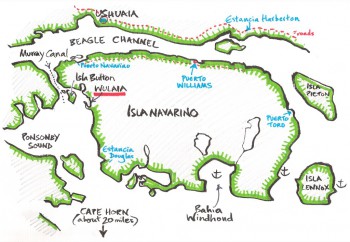 The Allen Gardiner set out from the Falklands, and on reaching Tierra del Fuego she sailed around the bottom of Isla Navarino and beat up into the bay at Wulaia. Aboard the boat, the missionaries must have been feeling a mixture of excitement and apprehension. At long last they were going to put into action the plan which had first been devised, almost a quarter of a century earlier, by Robert Fitzroy: They were going to set up a base amongst the savage indians of this cold and desolate region and ‘lead them to the Lord’. Meanwhile, the small group of Yaghans who had spent time at the missionary base in the Falklands were surely feeling unbounded joy; at long last they would be reunited with their family and friends.
The Allen Gardiner set out from the Falklands, and on reaching Tierra del Fuego she sailed around the bottom of Isla Navarino and beat up into the bay at Wulaia. Aboard the boat, the missionaries must have been feeling a mixture of excitement and apprehension. At long last they were going to put into action the plan which had first been devised, almost a quarter of a century earlier, by Robert Fitzroy: They were going to set up a base amongst the savage indians of this cold and desolate region and ‘lead them to the Lord’. Meanwhile, the small group of Yaghans who had spent time at the missionary base in the Falklands were surely feeling unbounded joy; at long last they would be reunited with their family and friends.
As soon as the schooner arrived she was surrounded by canoes, but the noise and excitement were such that the crew could not tell whether they were welcome or the opposite. There then occurred an event which was to sour whatever cordial relations might have been established; an event which also demonstrated how little the distance which the tame Yaghan had travelled along the road to civilisation. Just as these people were about to be put ashore with their belongings, one of the sailors reported to the captain that several items had suddenly gone missing. The order was given for the Yaghan’s bundles be searched, and on hearing this command, one of the natives hurled himself at the captain and grabbed him by the throat. Doubtless he intended to break the man’s neck, in the Yaghan’s accustomed manner, but the captain was able to throw his assailant to the deck. Sure enough, when the bundles were searched the missing property was found.
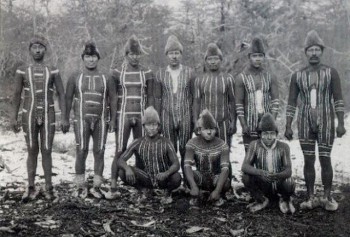
One cannot help but wonder how the Yaghan indians had been treated while they were guests of the mission at Keppel; and, given the state of English society at that time – and given the lack of comprehension displayed by these single-minded, myopic missionaries – one finds oneself obliged to conclude that they were surely treated as third class citizens. No doubt Robert Despard and his pals were compassionate men who meant well, but, unlike Fitzroy, they did not have the manners enabling them to treat both a duchess and a peasant with equal good grace. Rather, they will have treated the Yaghan just as they would have treated the lowest English peasant. It will not have occurred to them to question the idea that these people, although equal in the eyes of their god, were actually inferior beings who needed to be taught and, if necessary, chastised.
Meanwhile, the Yaghan had been born free. Seduced to leave home and live amongst these foreigners, by promises of ample good food and nice clothes, they subsequently found themselves trapped in what must surely have amounted to a prison commune. In all probability they will have been obliged to live according to a timetable devised by their supposed benefactors, rising at whatever hour the pastor appointed, and labouring, whether they liked it or not, at whatever task he dictated. In this age, little English boys were beaten with a rod if they failed to learn their letters, and it seems unlikely that men and women who disdained to weed the garden or scrub the floor were treated any better. At the very least, it will have been a case of, either you do as you’re told or you don’t get fed.
Despite the inauspicious beginning, the plan for the foundation of a European settlement at Wulaia went ahead. A house and a little wooden church were constructed, with materials shipped down from England, and the men also put up a fence. To any of the natives who had received any European education it will have been clear that they were staking a claim – right here, in the middle of the Yaghan village! While this work was under way, Jemmy Button and one of his brothers hung around, begging and pestering for whatever their eyes fell upon. Instead of recognising that these men were essential allies who must, at all costs, be kept on their side, the missionaries regarded them as a thorough nuisance. And that was one more more nail in their coffin.
After a week, the church was ready and on the 6th November 1859, the pastor – one Garland Philips – decided to hold the first ever Christian service on Tierra del Fuegian soil. The entire ship’s company, with the exception of the cook, went ashore in the long-boat and, “armed only with the Bible”, as the story goes, they assembled in the new building. Meanwhile, some 300 natives gathered outside. If Philips thought that they had come to join in with the holy ceremony he was about to be very disappointed.
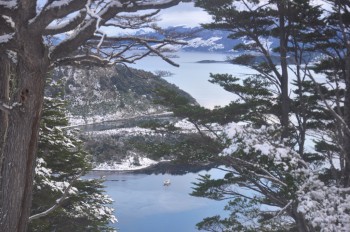
Watching from the deck of the schooner, the cook heard the first lines of a hymn; and then the music stopped abruptly and there was shouting and screaming. Some of the natives ran to the long-boat, took out the oars, and cast it adrift. Philips and one of the sailors came rushing out of the church and made a dash towards the shore. The sailor was quickly surrounded and clubbed to death. The pastor made it to the water and even managed to wade out to the drifting long-boat, but as he was trying to climb aboard he was felled by a stone. According to the cook, the stone was slung by none other than Jemmy Button’s brother. None of the other men even made it out of the church.
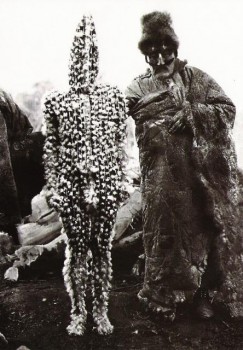
The Allen Gardiner was armed with two small cannons, and there were also several firearms aboard, but the cook was in too much of a panic to think of using them. He jumped into the dinghy and rowed for his life. The Yaghan came after him in their canoes, but he reached the shore and ran into the woods. The indians were not interested in following a lone, unarmed man; instead, they rushed back to the anchorage and joined their fellows in looting the ship. That was what it was all about, really; Button and his friends felt that they had not been given enough stuff, and so they had decided to help themselves.
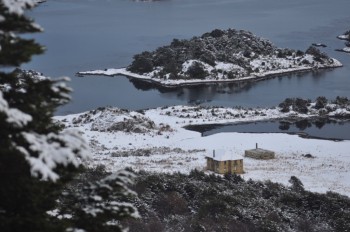
The cook spent the next few days hiding in the woods by day and venturing onto the beach at night to scavenge for mussels. The weather must have been reasonably mild, or else he wouldn’t have survived. Eventually, the Yaghan found him, but by now their spleen had been vented and they were not inclined to kill the man. Instead, they took him into their village. Afterwards, the cook was to complain that he had been tortured, but in fact his treatment at the hands of his captors was very fair. They stripped him naked and they plucked out his beard, his eyebrows, his pubic hair, and his body hair, and then they showed him how to make his own tools and catch his own fish. In short, they did exactly what the English had done when they took away Jemmy and the other Yaghan and forced them to conform to Victorian social norms. (The Yaghan also plucked out their own body hair and facial hair.)
Five months passed before Despard began to wonder why the Allen Gardiner hadn’t returned to base. He sailed from Keppel Island to Port Stanley, and here he was able to engage another schooner to go in quest of the missionaries. On their arrival, the rescue party found the mission vessel gutted of everything except her masts; and on board the ship they found the sea cook, stark naked and covered in boils, and driven half crazy by his experience.
During the months which had passed since the massacre, the Yaghan at Wulaia had had time to regret their hot-headed actions. Jemmy well knew that, if they wanted to, the English could obliterate the entire village. He understood all about vengeance; his own people were particularly vengeful, operating a formal system of reprisal against the family of anyone who had committed a murder. Moreover, Jemmy and those of the Yaghan who had spent time at Keppel Island had been taught all about the Englishman’s god – that wrathful being who punishes sin. Since he was not very evident, they might previously have reckoned that this Being didn’t amount to much, but in the immediate aftermath of the massacre he had suddenly smitten them hard. Large numbers of the natives had fallen ill and died. This surely created more fear than even the thought of guns and cannons; and thus it was that, when the rescue ship arrived and anchored, the indians were decidedly meek and helpful. Whereas before they had begged and stolen, now Jemmy and his friends ran around fetching firewood and water as the English required; and after the Allen Gardiner had been re-rigged and the two ships were ready to sail, that treacherous man volunteered to come to Keppel Island (which was a thing that he had previously refused to do) and give evidence about the murder of the missionaries.
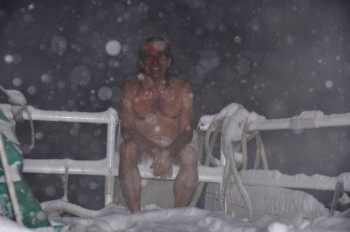
When the enquiry was held, Jemmy’s evidence completely contradicted that of the cook, for he insisted that the massacre was the work of the Selk-nam indians, who lived on the greater island of Tierra del Fuego. Whereas the Yaghan seem to have been descended from a people who made their way down the coast of Chile, the Selk-nam are thought to have originated on the Argentine plains and in the Andean foothills. Unlike the Yaghan, they wore skins derived from the guanaco which they hunted; and unlike the Yaghan they didn’t have canoes. These two facts are probably associated, for there can be few things nastier than sopping wet moccasins… but let’s stay with the story. Regardless of what one thinks of the cook’s testimony against Jemmy (and it has to be said that the ship cannot have been anchored sufficiently close for the man to identify the individual indians without the aid of a telescope), it was obvious that Jemmy Button was lying. The director of the mission, George Despard, considered sending out a punitive expedition, but in the end he came to his senses and saw that such an act would not be supportive of the gospel, which he was seeking to teach, of forgiveness.
The loss of their friends was a bitter blow to the devout people at Keppel Island. They found it incredible that the men whom they had treated with such kindness should have turned against them. One can readily understand their confusion and their disbelief, but at the same time one feels that by now it ought to have been perfectly clear that the Yaghan totally rejected the European lifestyle. Whilst they were delighted to be given useful things, such as knives and cloth, the indians were not willing to work for them; they saw that the price was too high. When offered the choice of a warm house and plenty of food, versus the uncertainties of a life lived in the nude on a frozen seashore, they much preferred hunger and habitual cold to the invisible bonds inherent in that safe, comfortable lifestyle. Many others have felt the same way. Indeed, the peasant folk of England felt the same way; it was not until their small plots of land were stolen from them through the enforcement of the Enclosure Act that they could be persuaded to move to the towns in vast numbers and give their labours and lives to the industrialists. And they were not even a free people in the first place, having been in bondage since the Celts over-ran the land!
With the benefit of hindsight it is clear that the Yaghan had no wish to be blessed with the advantages of civilisation. But civilisation refused to go away.
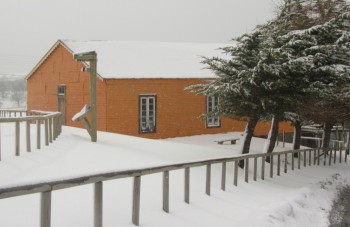
It was to be another ten years before they finally managed to get a toe-hold in this region, but in 1869 one of George Despard’s adopted sons came to Tierra del Fuego with another missionary by the name of Stirling. Thomas Bridges had learnt the Yaghan language during his childhood on Keppel Island, and he was therefore able to communicate with the natives in a way that no previous white man had done. Having visited Wulaia (and found Jemmy still alive and well and still fearing retribution), and having attempted to settle in a couple of other places, the duo chose a location on the opposite side of the Beagle Channel in a bay known to the Yaghan as Ushuaia. And so was a city born.
The corrugated iron house which Thomas Bridges and the Reverend Stirling inhabited at Ushuaia made several moves before eventually ending up in Puerto Williams. It is now a museum piece, but it is not open to the public.
As for Wulaia, in the last years of the 19th century it was visited by two Yugoslavian gold prospectors. These adventurers found no gold, but they decided to stay anyway and set up the first Fuegian cattle ranch. The ranch continued in their families’ ownership until the 1950s. What the Yaghan thought of it, one does not know, but perhaps by this time they had all been rounded up and taught to wear clothes and look after the white-man’s cattle.
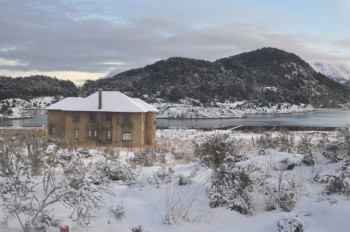
In the 1930s a large brick house was erected close to the farm buildings and this housed a radio station. It was abandoned in the 1960s and, having for a long time lain empty, it has recently been made into a museum. A plaque on the front wall commemorates the fact that this is the very place where Fitzroy and Darwin landed and tried to set up a mission.
Yes, Wulaia is where the European conquest of “the uttermost part of the earth began”; but, truth to tell, after all that courage and determination and faith, the only thing that was actually conquered was the very thing that those well-meaning meddlers came to save. At Wulaia we catch a glimpse of what once was. Through half closed eyes I see three score of Yaghan wigwams scattered along the shore with smoke wafting through their ill-thatched roofs; and I imagine the people coming and going in their canoes, with each one trailing a skein of smoke. I hear the laughter of the children; I hear the women calling to one another as they gather mussels on the beach at low-tide. I see palaeolithic people much like our own ancestors. I see them peering anxiously at a bunch of trousered and jacketed men…
It is reckoned that at the time of Fitzroy and Darwin’s visit to this region there were some 3,000 Yaghan, but by the late 1920s there were fewer than fifty. The majority of their kin had been clothed and fed a European diet and had succumbed to measles and such-like. The arrival of gold prospectors at the Mission in Ushuaia had done them no good at all, but even after Thomas Bridges moved them along the coast to Harberton they still fell ill. Meanwhile, the Selk-nam (who inhabited the interior of Tierra del Fuego) had been hunted almost to extinction by cattle farmers.
The remaining Yaghan were encouraged to settle in Puerto Williams, in a place known as Ukika. Here it was that the last Yaghan thoroughbred died, in the 1990s. Her half-blood children and grandchildren now carry the banner and are feted in much the way that Jemmy Button was. If you’re passing this way you can barter for their hand-crafted model canoes and point your camera at their rather ordinary tin-covered shacks.
